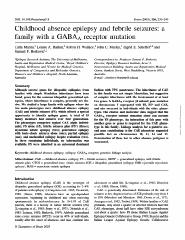Please use this identifier to cite or link to this item:
https://ahro.austin.org.au/austinjspui/handle/1/9453| Title: | Childhood absence epilepsy and febrile seizures: a family with a GABA(A) receptor mutation. | Austin Authors: | Marini, Carla;Harkin, Louise A;Wallace, Robyn H;Mulley, John C;Scheffer, Ingrid E ;Berkovic, Samuel F | Affiliation: | Epilepsy Research Institute, The University of Melbourne, Austin and Repatriation Medical Centre, West Heidelberg, Victoria, Australia | Issue Date: | 1-Jan-2003 | Publication information: | Brain : A Journal of Neurology; 126(Pt 1): 230-40 | Abstract: | Although several genes for idiopathic epilepsies from families with simple Mendelian inheritance have been found, genes for the common idiopathic generalized epilepsies, where inheritance is complex, presently are elusive. We studied a large family with epilepsy where the two main phenotypes were childhood absence epilepsy (CAE) and febrile seizures (FS), which offered a special opportunity to identify epilepsy genes. A total of 35 family members had seizures over four generations. The phenotypes comprised typical CAE (eight individuals); FS alone (15), febrile seizures plus (FS(+)) (three); myoclonic astatic epilepsy (two); generalized epilepsy with tonic-clonic seizures alone (one); partial epilepsy (one); and unclassified epilepsy despite evaluation (two). In three remaining individuals, no information was available. FS were inherited in an autosomal dominant fashion with 75% penetrance. The inheritance of CAE in this family was not simple Mendelian, but suggestive of complex inheritance with the involvement of at least two genes. A GABA(A) receptor gamma2 subunit gene mutation on chromosome 5 segregated with FS, FS(+) and CAE, and also occurred in individuals with the other phenotypes. The clinical and molecular data suggest that the GABA(A) receptor subunit mutation alone can account for the FS phenotype. An interaction of this gene with another gene or genes is required for the CAE phenotype in this family. Linkage analysis for a putative second gene contributing to the CAE phenotype suggested possible loci on chromosomes 10, 13, 14 and 15. Examination of these loci in other absence pedigrees is warranted. | Gov't Doc #: | 12477709 | URI: | https://ahro.austin.org.au/austinjspui/handle/1/9453 | Journal: | Brain | URL: | https://pubmed.ncbi.nlm.nih.gov/12477709 | Type: | Journal Article | Subjects: | Adult Child, Preschool Chromosomes, Human, Pair 13 Chromosomes, Human, Pair 14 Chromosomes, Human, Pair 15 Electroencephalography Epilepsy, Absence.complications.genetics.physiopathology Female Genes, Dominant Genetic Linkage Humans Male Mutation Pedigree Penetrance Phenotype Receptors, GABA-A.genetics Seizures, Febrile.complications.genetics.physiopathology |
| Appears in Collections: | Journal articles |
Files in This Item:
| File | Description | Size | Format | |
|---|---|---|---|---|
| 12477709.pdf | 430.82 kB | Adobe PDF |  View/Open |
Page view(s)
40
checked on Nov 9, 2024
Download(s)
124
checked on Nov 9, 2024
Google ScholarTM
Check
Items in AHRO are protected by copyright, with all rights reserved, unless otherwise indicated.
